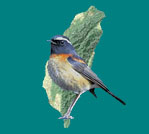|
Jo Ann Mackenzie describes the
NATIONAL BIRD CAMPAIGN Vote Choices
Formosan Magpie
Formosan Magpie, sometimes called Taiwan Blue Magpie,
is a very beautiful bird. Birding in Taiwan
participants, seeing it for the first time, always react with
words as “Wow! Gorgeous!”
Similar to the Swinhoe’s and Mikado Pheasants,
it is coloured black, blue, red and white, but it is usually
easier to locate and to see. With a body length, from beak tip
to tail tip of 63 to 69 cm, it is large, but not as large as the
pheasants. It is a species of hills and mountains, found at
elevations of 300 to 1200 m, but does not require the solitude
of the pheasants. Taiwanese who have a never seen a pheasant or
a Yellow Tit, have perhaps seen a Formosan Magpie. This bird
can be found in Yangmingshan
National Park, just to the north of Taipei, and so may be
familiar to people who don’t travel to Taiwan’s Central
Mountains, where Swinhoe’s and Mikado Pheasants, and Yellow Tit,
reside.
My most memorable encounter with Formosan Magpie
took place in November 2003, in Yangmingshan, where our group
saw ten magpies, flying in single-file, “long-tailed
formation,” through the park. “Wow! Gorgeous!”
VOTE FOR
TAIWAN'S NATIONAL BIRD
Swinhoe’s Pheasant &
Mikado Pheasant
I have been to Taiwan
7 times, and always enjoy the birds. On my first trip, in March
2003, the group and I were lucky to see two stunningly beautiful
male Swinhoe’s Pheasants on a rainy day at Beidongyenshan. I
promised myself that someday, I would be lucky enough to see a
Mikado Pheasant, too. That day came soon after.
Our Birding in Taiwan tour group was at
Anmashan in November, 2003; we were going to walk the famous
Trail 210 to look for pheasants, guided by Simon Liao and Wu Ten-Di, whose excellent birding skills are
well known. We had been told that a female Mikado with young
were often seen near the trailhead at first light. And so, we
were there very early in the cold morning. We waited and
watched. The sun rose; the morning grew brighter. The hen
pheasant and her chicks did not appear. Disappointed, some of
the group decided to walk on; others decided to stay near the
trailhead. I walked on. After a while, I thought I should
return to the trailhead and check on my husband, Hue, who had decided to stay behind. I found that he was
fine, and I turned around to continue on the trail, hoping to
catch up with the others. They soon met me, returning
triumphantly, as they had seen Mikado Pheasant not long after I
had left them! Disappointment for me, again!
Determined not to be defeated, I walked on
slowly, accompanied by Ten-Di. About 2 km from the trailhead,
Ten-Di stopped and motioned for me to look quickly down the
trail. A red, white and blue male Swinhoe’s Pheasant was slowly
stepping along in the middle of the track! Beautiful—but not
quite what I was hoping for. We kept going, walking very
slowly, softly, as quietly as possible, peering cautiously
around each bend in the trail. Suddenly, silently, Ten-Di
grabbed my arm and urgently motioned ahead. Astoundingly, there
were TWO gorgeous, blue-black male Mikado Pheasants standing on
the trail! Oh, joy! I had been cautioned that if we saw
Mikados at all, it would be a fleeting, split-second glimpse—in
view one second, gone the next. On the contrary, these two just
stood there, unconcerned. I was enchanted! We watched them
for about 2 minutes, then the birds calmly, sedately, walked off
the trail and disappeared through the undergrowth on the
mountainside. Success!!! Ten-Di and I looked at each other,
smiling happily. We turned around and started back toward the
trailhead, about 3 km away. Just then, Hue arrived,
having given up waiting for the hen and chicks, and hoping to
catch up with us. It was too late for him to see the Mikados,
unfortunately. Hue had to wait 3 more years and a total of 5
visits to Taiwan to see Mikado Pheasant, but eventually, he,
too, was successful.
VOTE FOR
TAIWAN'S NATIONAL BIRD
Taiwan Tit (Yellow Tit)
Yellow Tit can be hard to find. Our Birding in
Taiwan group was lucky with it in March, 2003. Yellow Tit
is a small bird, lemon-yellow below with black upperparts. The
white tips of the crest feathers can be hard to see as the bird
is often high in the trees. A bird of mid- to high elevation
forests, it is uncommon and inconspicuous. It may mix with
other small birds, or occur alone. I have seen it many times
since that first encounter; at Huisun Forest Station, Meifeng,
Aowanda and Alishan. A shout of “Yellow Tit!” always
brings other birders running.
VOTE FOR
TAIWAN'S NATIONAL BIRD
黑長尾雉:
雄鳥,大型高雅黑色長尾的雉雞,肩羽及腰部具特殊光澤的藍紫色,全身黑色的羽毛上形成明顯的貝狀纹。 尖直長的尾羽黑白相間,翼黑色,有明顯的白紋。臉部裸露皮膚為朱紅色。雌鳥較小,體下為灰色具雜斑,體上半身褐色,具紅及黑色斑紋,與褐白色的縱紋。眼褐色,喙灰色,腳綠褐色。
牠是不普遍的留鳥,棲息在中央山脈海拔1800到3300公尺或更高的陡坡上,生活範圍在森林下層濃密植叢及竹林中,以及山區針葉林、針闊混生林。
性羞怯而喜隱密。雜食性,食物包括漿果、花苞及昆蟲。繁殖期以竹枝及乾葉築巢於倒木的樹幹旁或分枝處,或是在地面營巢,大小約裝2至8顆蛋。孵化期約28天。
黑長尾雉為接近受脅等級的鳥種。過去因捕獵使本種受到最大的威脅,但已有改善。在保育區以外,因陸續的棲地喪失而導致族群數量減少,然而在高海拔的國家公園區仍相當安全。
別名:帝雉,烏雉,海雉。
國鳥候選者
背景資料
藍腹鷴:
雄鳥,大型深藍色的雉雞,有著白色的短羽冠,上背及中央尾羽為白色。肩羽暗紫紅色,全身羽色大致為黑絲絨色,體上帶有具光澤的藍綠色鱗狀斑,體下為藍綠縱紋,臉部裸皮及肉垂紅色。雌鳥,體型稍小,全身大致為灰褐色的規則斑紋,翼上有細纹,翼及尾側栗色,沒有羽冠且臉部的肉垂較小,體下為棕褐色帶黑色橫紋。眼褐色,喙淡黃色,腳紅色。
棲息於海拔300到2800公尺的原始林及成熟潮濕的硬木次生林。
性羞怯而機警,食性雜,食物包括堅果、漿果、花苞及嫩葉,也食用蚯蚓、多足類、白蟻。晨昏時常沿著林道邊的植叢活動,以掘取的方式覓食。在3到7月繁殖期,雄鳥會有繁殖展示翅膀的行為。築巢於樹基或是岩石下。巢可裝3到8顆蛋。繁殖期25天。
藍腹鷴被列為全球接近受脅鳥種,過去的非法盜獵使本種受大最大的威脅。在1960到1970年代,本種在多處地點消失,但在許多適宜的棲地中仍算常見。在保護區內的數量應可維持,於其他地點種群數量可能仍因捕獵而數量少。
別名:藍鷴、山雞、紅脚山雞、華雞。
國鳥候選者
背景資料
台灣藍鵲:
體長約有63~69公分的藍鵲,尾羽佔了40公分。全身羽色包括體下都是琉璃藍色,頭、頸及胸部為黑色,喙、腳紅色,眼淺黃色,6對尾羽的中央尾羽特別長,每支尾羽末端為白色。
如其他的鴉科(巨嘴鴉、藍鵲、喜鵲)一般,台灣藍鵲是非常聰明的。牠們分布在中、低海拔及丘陵林地,最高到海拔1800公尺,但到冬季時會到低地平原度冬(海拔50公尺)。
台灣藍鵲是雜食性,以水果、昆蟲、蜥蜴、蛇、鳥蛋、鳥和其他小型動物為食。牠們特別喜歡木瓜、香蕉和其他水果。鳴聲為連續性的『嘎、嘎、嘎』聲音。繁殖期在4到8月時。為合作繁殖者,巢以樹枝堆成,築於高大的樹上層。每巢約3到8顆蛋。
台灣藍鵲常以『長尾陣式』的排法飛行。
別名:長尾山娘。
國鳥候選者
背景資料
黃山雀:
黃山雀的體型嬌小,體長13公分並有長的羽冠。雄鳥前額、頰及體下鮮黃色。肛門、頭頂、羽冠、背和翼覆羽為黑色。羽冠末端白色。翼淺藍色外緣白色。雌鳥羽冠較短,背欖綠色,沒有肛部黑點。幼鳥體色較淡,體下偏白色,眼深棕色,喙黑色,腳灰色。
本種列為稀有或局部普遍的鳥種,棲息於中央山脈山區海拔700到2500公尺的溫帶闊葉林中。通常是成對或成小群的活動。在非繁殖期可能會混入其他小型鳥種,形成混合覓食群,在樹中層活動。在4月繁殖,築巢在高大樹木的樹洞中,每巢約3到4顆蛋。
國際鳥盟將黃山雀列為接近受脅的鳥種。黃山雀一向就不普遍,主因是闊葉木森林棲地被大量砍伐而致。本種不太能利用條件稍差的棲地,例如灌叢樹林邊緣,或是針葉林及竹林造林地區等。過去本種曾出現在野鳥大規模捕捉出口貿易的名單中。目前在國家公園、自然保留區,以及野生動物保護的棲地都相當穩定。
別名:台灣四十雀,師公。
國鳥候選者
背景資料
Peter
Candido describes the National Bird Campaign Vote Choices
Rob
Butler describes the National Bird Campaign Vote Choices
|

